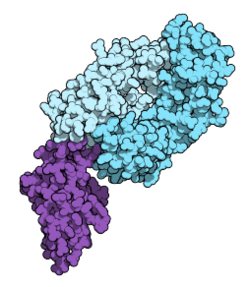Nivolumab
| Nivolumab | ||
|---|---|---|

|
||
| according to PDB 5GGR | ||
| Mass / length primary structure | 143,597 Da | |
| Identifier | ||
| External IDs |
|
|
| Drug information | ||
| ATC code | L01 XC17 | |
| DrugBank | DB09035 | |
| Drug class | Monoclonal antibodies | |
Nivolumab (trade name Opdivo ) is a checkpoint inhibitor that is used as an active ingredient against various tumors. It is a human (completely human) monoclonal antibody that binds to the PD-1 receptor on T cells and prevents interaction with the PD1 receptor ligand that actually binds here. In this way the immune system is indirectly stimulated by suppressing the inhibitory influence of the PD1 ligand / PD1 receptor system.
Passed in 2016 for the preparation of the manufacturer Bristol-Myers Squibb in Switzerland approvals from non-small cell lung cancer , malignant melanoma , squamous head and neck cancer and renal cell carcinoma , adenocarcinoma of the stomach and gastroesophageal junction, urothelial carcinoma , metastatic colorectal cancer and the disease Hodgkin . The drug is available under different drug names for the various indications.
A combination of nivolumab with ipilimumab is more effective than anti-PD1 monotherapy in some melanomas . Nivolumab can be administered as adjuvant therapy after complete surgical metastasis removal.
See also
Web links
- Nivolumab , Cancer Society Information
literature
- Ju Yeon Lee, Hyun Tae Lee, Woori Shin, Jongseok Chae, Jaemo Choi, Sung Hyun Kim, Heejin Lim, Tae Won Heo, Kyeong Young Park, Yeon Ji Lee, Seong Eon Ryu, Ji Young Son, Jee Un Lee, Yong- Seok Heo: Structural basis of checkpoint blockade by monoclonal antibodies in cancer immunotherapy . In: Nature Communications . tape 7 , 2016, 13354, doi : 10.1038 / ncomms13354 (free full text).
Individual evidence
- ↑ Product information. Retrieved October 6, 2018 .
- ↑ Patrick Terheyden, Angela Krackhardt, Thomas Eigenler: System therapy of melanoma. Use of immune checkpoint inhibitors and inhibition of intracellular signal transduction. In: Deutsches Ärzteblatt. Volume 116, Issue 29 f., (July 22) 2019, pp. 497-504, especially p. 503.